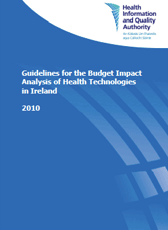Budget Impact Analysis (BIA) guidelines will provide health service managers who have to make hard decisions with the best possible information on the best use of healthcare resources, writes Dr. Mάirίn Ryan.
Ireland is not unique in trying to efficiently manage the spiralling cost of advances in healthcare technologies such as drugs, devices, medical and surgical procedures, screening programmes etc.. However, given Ireland’s economic crisis, the public, taxpayers, and healthcare providers must be assured that healthcare therapies and procedures that are deployed work effectively and provide value for money.

Therefore, it is pertinent to consider the impact that health technology assessment (HTA) has on securing better use of public monies on health and social care services here. The Health Information and Quality Authority has a statutory remit to assess the clinical and cost-effectiveness of these technologies. It advises the Minister for Health and Children and the Health Service Executive (HSE) on these assessments. Up to now, Ireland has not had systematic assessment of all health technologies.

The main audience for HTA in Ireland is decision makers within the publicly funded health service (the Minister and the Health Service Executive), although HTA does have implications for other key healthcare stakeholders. As part of an ongoing process to update existing guidelines on various elements of HTA, the Authority has just published new guidelines on costing healthcare treatments. The Guidelines for the Budget Impact Analysis of Health Technologies in Ireland http://www.hiqa.ie/media/pdfs/HTA_Guidelines_for_Budget_Impact_Analysis.pdf will, in the current economic climate play a valuable public-interest role.
This ‘how to’ document offers a range of advice on conducting BIA in the Irish healthcare setting, for example, how to compare existing treatments to the technology being assessed.
A tool
Applying the budget impact analysis (BIA) guidelines will provide health service managers who have to make hard decisions with the best possible information on the best use of healthcare resources. The guidelines were developed by the Authority with technical input from the National Centre for Pharmacoeconomics and in consultation with the Authority’s Scientific Advisory Group (SAG), following feedback on a draft set of guidelines. The Authority believes that the use of the guidance is vitally important to help deliver a better quality service to the public.
Ireland does not have a central medical costs database and, as a result, the generation of valid data for Ireland is challenging and time consuming
Budget impact analysis has been defined as a tool to predict the potential additional financial impact of the use of a new technology in a healthcare system with finite resources. The publication of the BIA guidelines follows the earlier publication by the Authority of HTA economic evaluation guidelines http://www.hiqa.ie/media/pdfs/HTA_Economic_Guidelines_2010.pdf. Although BIA and economic evaluations – which address both the cost of health technologies and the health benefits associated with them – have many similarities, there are some other key distinctions between the two approaches in HTA, including:
- BIA is not an economic analysis, but is based on the principles of accounting.
- Economic evaluations are typically not modelled for the actual anticipated size of the patient population, whereas BIA is.
- BIA is typically concerned with costs over a shorter time span, whereas the time horizons required in economic evaluations are generally much longer.
Budget impact analysis helps to forecast how adopting a new technology for a given condition will impact on the overall expenditure for that condition. BIA may then be used to:
- Provide data to inform an assessment of the affordability of a technology at a given price for a specific population prior to its reimbursement.
- Provide a budget or service planning tool to inform decisions regarding the allocation or re-allocation of resources subsequent to a decision to reimburse a technology.
While the BIA should be conducted from the perspective of the publicly-funded health and social care system in Ireland, the guidelines point out that it is permissible to adopt a broader or a narrower perspective in some cases. For instance, it may be justified when there may be significant budget implications for other publicly funded services, such as health technology interventions that enable patients to return to work. A narrow perspective may be useful for BIA conducted at the local healthcare level, such as a move to introduce a new technology within an individual hospital or clinic setting.
The guidelines will apply to all healthcare treatments, including medications, procedures, medical devices, broader public health initiatives, and service delivery models
Ireland does not have a central medical costs database and, as a result, the generation of valid data for Ireland is challenging and time consuming. Therefore, the guidelines point to the need for flexibility regarding the costing of resources until such time as a valid Irish cost model is established. The BIA guidelines published by the Authority also make important distinctions between the total cost of a technology less what would have been spent on the current standard of care.
Transparent
Meanwhile, the guidelines also stress that the BIA model used should be transparent, with all assumptions and limitations in the reporting of BIA clearly stated. There is also considerable uncertainty in a BIA. As it aims to inform financial planning and resource allocation, it is crucial that the decision maker has an appreciation of the level of uncertainty inherent in the estimates and this should be explored in the BIA. The final analysis should summarise a range of realistic scenarios, rather than a single ‘best estimate’ of the results. The BIA guidelines outline the best methods to provide findings that are representative of differences between technologies as opposed to differences in how they were assessed.
The guidelines have been approved by the Board of the Authority and have been submitted to the Department of Health and Children. The Authority will be developing other related documents that will include guidelines on the social, ethical and organisational aspects of HTA.
The guidelines, which will be reviewed and revised as necessary, will apply to HTA being conducted by, or on behalf of the Health Information and Quality Authority, the National Centre for Pharmacoeconomics, the Department of Health and Children, and the Health Service Executive (HSE). They will apply to all healthcare treatments, including medications, procedures, medical devices, broader public health initiatives, and service delivery models. Consequently, they are broad in scope and aspects may be more relevant to particular interventions than others. They are relevant to new and existing healthcare technologies, and health technology suppliers preparing applications for reimbursement.
The use of resources is a major theme of the Authority’s Draft National Standards for Safer Better Healthcare. http://www.hiqa.ie/media/pdfs/Safer_better_care_draft_standards_A4.pdf. This is important because decisions about how resources are used will have a fundamental impact on the quality and safety of services. Resources are limited and therefore the effective, responsible stewardship of resources is a fundamental success factor in delivering high quality, safe and reliable healthcare. To do this, we are proposing, amongst other measures under these standards, that service providers regularly review and assess the efficiency and cost-effectiveness of the services and technologies that they provide, by using the best available evidence. HTA, including its BIA constituent, will play a valuable role in achieving this objective. BIA complements other HTA components, such as medical, social, economic evaluation and ethical assessment of a technology. As a major HTA may be time and labour intensive, a BIA may be conducted on its own to help determine the financial impact of a technology. This can then be used as one of the criteria to determine whether or not the expense of a full HTA is warranted.
Dr. Mάirίn Ryan is Director of Health Technology Assessment, Health Information and Quality Authority

